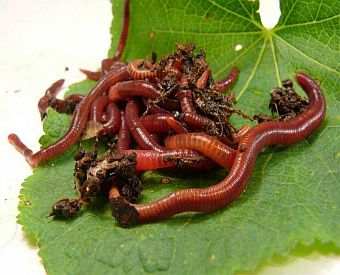Live red worms: Tips for care a worm bin
Live red worms: Tips for care a worm bin
Blog Article
Every Little Thing You Required to Understand About Red Wigglers for Composting
Red wigglers, or Eisenia fetida, play a critical role in the realm of composting, changing organic waste into valuable dirt amendments. The procedure of setting up a worm container and preserving it can present difficulties.
What Are Red Wigglers?

(Lake James Bait)
Belonging To North America, red wigglers are surface-dwelling organisms that prefer damp, warm environments rich in breaking down raw material. Their diet is composed primarily of decomposing plant product, food scraps, and other natural debris, which they eat and break down efficiently. As they absorb this material, they produce nutrient-rich spreadings that enhance soil fertility.
Red wigglers are hermaphroditic, possessing both male and women reproductive organs, and can recreate swiftly under optimal conditions. This capacity makes them an ideal choice for composting systems, as their population can enhance swiftly. Their strength and versatility to various environments further solidify their value in lasting waste administration practices. On the whole, red wigglers are important factors to the procedure of reusing organic waste right into useful garden compost.
Benefits of Using Red Wigglers
Using red wigglers in composting systems supplies various benefits that boost both the effectiveness of waste administration and the high quality of the resulting compost. These worms, clinically referred to as Eisenia fetida, are especially reliable at breaking down organic matter, transforming kitchen area scraps and yard waste into nutrient-rich garden compost at a sped up price.
Among the main advantages of using red wigglers is their ability to eat big quantities of natural material, commonly refining their weight in food waste daily. This high usage price causes much faster disintegration and lowers the volume of waste sent out to garbage dumps. Moreover, the spreadings produced by red wigglers are rich in vital nutrients, valuable bacteria, and enzymes, making them a superb fertilizer for gardens and plants.
In addition, red wigglers thrive in a variety of settings, making them adaptable for both interior and exterior composting systems - red wigglers. Their visibility in a compost bin assists to aerate the product, preventing odors and promoting a healthy and balanced composting process. In general, employing red wigglers not just adds to effective waste monitoring yet additionally sustains sustainable gardening techniques with the production of top quality garden compost
(Lake Rhodhiss Bait)
Establishing Your Worm Bin
To efficiently establish a worm container, it is necessary to select an ideal container that fulfills the needs of red wigglers while supplying a helpful environment for composting. An appropriate bin can be made from plastic, wood, or steel, with an ability of at the very least 1 square foot for each extra pound of worms.
Ensure the container has adequate water drainage openings to stop excess moisture, as red wigglers grow in a damp, but not waterlogged, setting. red wigglers. The container must likewise be ventilated to give enough air flow, avoiding anaerobic conditions that can damage the worms
A suitable place for the worm container is a trendy, dark area, devoid of straight sunshine and extreme temperature levels, as red wigglers like a temperature variety of 55 to 77 levels Fahrenheit.
Before introducing the worms, prepare bed linen products such as shredded paper, cardboard, or coconut coir, which will certainly offer both habitat and food. Moisten the bed linen lightly to create a welcoming atmosphere for the worms. Lastly, consider placing a lid on the container to preserve moisture and minimize parasites, while guaranteeing it can be conveniently eliminated for maintenance.
Feeding and Treatment Guidelines
Feeding red wigglers is an important element of maintaining a healthy composting system. These worms grow on a varied diet regimen, mainly composed of organic products such as vegetables and fruit scraps, coffee grounds, and crushed eggshells. It is vital to prevent feeding them meat, dairy, and oily foods, as these can create undesirable odors and attract bugs.
When presenting food to your worm bin, cut or shred products right into smaller sized pieces to facilitate quicker decay. Beginning with little amounts to assess the worms' intake rate, progressively enhancing the quantity as they adapt. It is suggested to alternate feeding places within the bin to encourage thorough mixing and aeration of the garden compost.

Troubleshooting Common Issues
Keeping a growing worm composting system can occasionally present difficulties that require interest and troubleshooting. Usual issues consist of an undesirable odor, Western North Carolina Bait which usually suggests overfeeding or the existence of anaerobic conditions. To treat this, decrease the quantity of food added and ensure appropriate aeration by mixing the bed linen material.
One more regular issue is the getaway of worms from the container. This can take place because of excessive dampness or unsuitable ecological conditions. Frequently check the dampness levels, going for a damp however not soaked consistency, and preserve optimum temperatures in between 60-80 ° F(15-27 ° C )to produce a comfortable environment for your red wigglers.
Pests, such as fruit flies, can additionally invade worm containers. red wigglers. To fight this, cover food scraps with a layer of bed linen or shredded paper to prevent flies from laying eggs. Furthermore, make certain that any food included is fresh and without mold and mildew, which can draw in unwanted insects
Last but not least, if your worms appear non-active, examine for stress variables such as temperature level changes or inadequate moisture. Dealing with these common problems will aid maintain a healthy and balanced and productive worm composting system.
Final Thought
In summary, red wigglers, or Eisenia fetida, play an important function in sustainable waste monitoring via vermicomposting. Appropriate arrangement and upkeep of a worm bin, along with adherence to feeding guidelines, guarantee a thriving ecological community that decreases garbage dump contributions.
Report this page